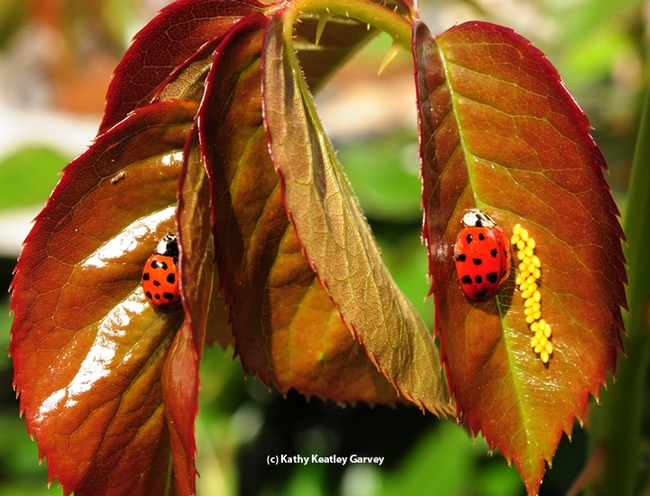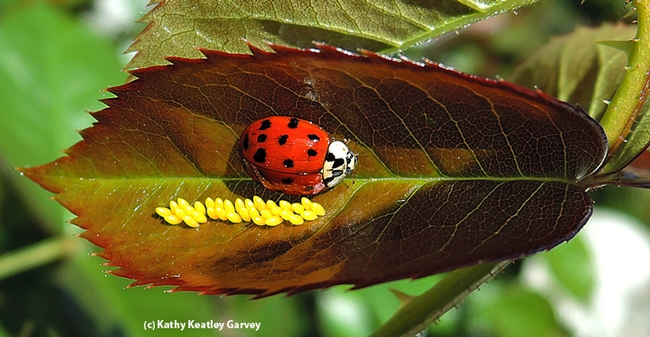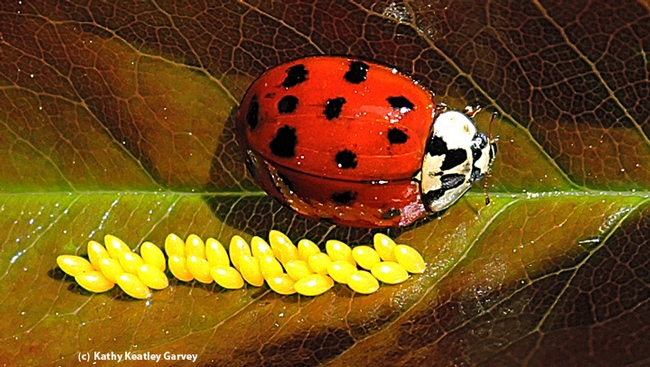- Author: Kathy Keatley Garvey
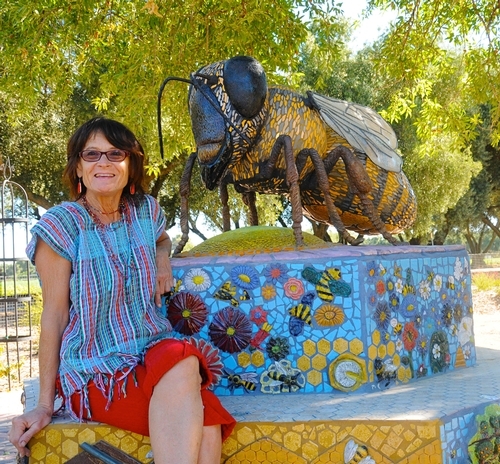
It was the fall of 2009 when a half-acre bee garden on Bee Biology Road, UC Davis campus, sprang to life.
Headlines on colony collapse disorder dominated the news media, as scientists declared "honey bees are in trouble."
Under the direction of interim department chair Lynn Kimsey, UC Davis Department of Entomology and Nematology, a crew installed the Häagen-Dazs Honey Bee Haven (named for it major donor) on Bee Biology Road, next to the Harry H. Laidlaw Jr. Honey Bee Research Facility.
Fast forward to the fall of 2019.
A 10th anniversary celebration will take place from 10 a.m. to 2 p.m., Saturday, Sept. 28. It will include sales of plants and native bee condos, honey tasting (honey from Sola Bee Honey, Woodland), catch-and-release bee observation and identification, and beekeeping and research displays. Several mini lectures are planned.
Visitors will see analemmatic sundial--the only one of its kind in the Sacramento area--and they can discuss the sundial with dial master and beekeeper Rick Williams, M.D. to learn how the dial was created and the links between human and bee perception of the sun. Visitors also will learn about "our research on bee use of ornamental landscape plants," said manager Chris Casey. In addition, visitors can "donate a book on insects, gardening, or nature for our Little Free Library," she announced.
The schedule:
- 10:30 a.m.: Donor and volunteer recognition
- 11 a.m.: Hive opening by beekeeper from the California Master Beekeepers' Association
- 11:30: Mini lecture, "Getting Started with Beekeeping"
- 12: Mini lecture, "Plants for Bees"
- 12:30: Mini lecture, "Using Solitary Bee Houses
- 1 p.m.: Hive opening by beekeeper from the California Master Beekeepers' Association
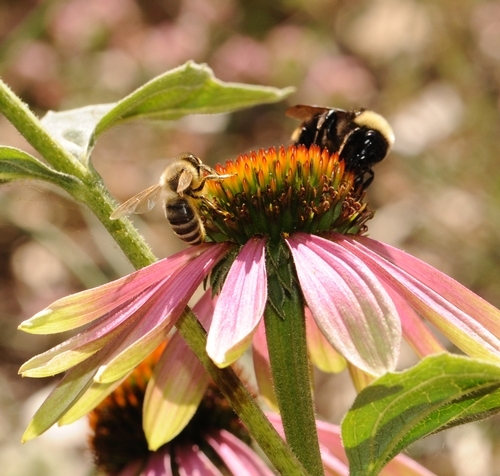
Häagen-Dazs wanted the funds to benefit sustainable pollination research, target colony collapse disorder, and support a postdoctoral researcher. It was decided to install an educational garden, conduct a design contest, and award a research postdoctoral fellowship to Michelle Flenniken (now with the Montana State University).
A Sausalito team--landscape architects Donald Sibbett and Ann F. Baker, interpretative planner Jessica Brainard and exhibit designer Chika Kurotaki--won the design competition. The garden was installed in the fall of 2009 under the direction of interim department chair Lynn Kimsey, director of the Bohart Museum of Entomology and professor of entomology.
An eight-member panel selected the winner of the design competition: Professor Kimsey; founding garden manager Missy Borel (now Missy Borel Gable), then of the California Center for Urban Horticulture; David Fujino, executive director, California Center for Urban Horticulture at UC Davis; Aaron Majors, construction department manager, Cagwin & Dorward Landscape Contractors, based in Novato; Diane McIntyre, senior public relations manager, Häagen-Dazs ice cream; Heath Schenker, professor of environmental design, UC Davis; Jacob Voit, sustainability manager and construction project manager, Cagwin and Dorward Landscape Contractors; and Kathy Keatley Garvey, communications specialist, UC Davis Department of Entomology.
Others who had a key role in the founding and "look" of the garden included the UC Davis Art/Science Fusion Program, founded and directed by the duo of entomologist/artist Diane Ullman, professor and former chair of the UC Davis Department of Entomology, and self-described "rock artist" Donna Billick. The art in the garden is the work of their students, ranging from those in Entomology 1 class to community residents. Eagle Scout Derek Tully planned, organized and built a state-of-the-art fence around the garden.
"The Honey Bee Haven will be a pollinator paradise," Kimsey related in December 2008. "It will provide a much needed, year-round food source for our bees at the Harry H. Laidlaw Jr. Honey Bee Research Facility. We anticipate it also will be a gathering place to inform and educate the public about bees. We are grateful to Haagen-Dazs for its continued efforts to ensure bee health."
The garden, Kimsey said, would include a seasonal variety of blooming plants that will provide a year-round food source for honey bees. It would be a living laboratory supporting research into the nutritional needs and natural feeding behaviors of honey bees and other insect pollinators.
Visitors to the garden, Kimsey related, would able to glean ideas on how to establish their own bee-friendly gardens and help to improve the nutrition of bees in their own backyards.
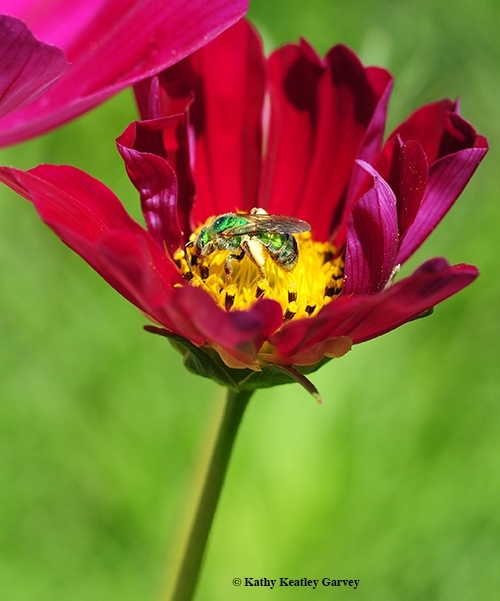
Feb. 19, 2008
Häagen-Dazs Donation to UC Davis
Dec. 8, 2008
Häagen-Dazs Launches Bee Garden Design Contest
Aug. 6, 2008
Insect Virus Researcher Michelle Flenniken Named Häagen-Dazs Postdoctoral Fellow at UC Davis
Feb. 26, 2009
Sausalito Team Wins Design Competition
Aug. 6, 2009
Haagen-Dazs Honey Bee Haven Site Preparation
Aug. 13, 2009
Bee Biology Website to Be Launched
Aug. 13, 2009
Thinking Outside the Box
Sept. 15, 2009
Campus Buzzway: Wildflowers
Dec. 15, 2009
Bee Biology Website Lauded
2010
June 6, 2010
Grand Opening Celebration of Honey Bee Garden
July 15, 2010
Art Is Where the Community Is; Blending Science with Art in the Häagen-Dazs Honey Bee Haven
July 30, 2010
More Than 50 Bee Species Found in Haven: Robbin Thorp (Now there's more than 80 and counting!)
Aug. 25, 2010
Donna Billick: Miss Bee Haven
Aug. 11, 2011
What the Signs Tell Us in the UC Davis Honey Bee Garden
Aug. 24, 2011
Royal Visit to Harry H. Laidlaw Jr. Honey Bee Research Facility
April 11, 2012
Brian Fishback: Spreading the Word about Honey Bees
Aug. 26, 2013
Eagle Scout Project: Fence Around the Bee Garden
2013
April 25, 2013
UC Davis Bee Team Wins Major Award
Aug. 1, 2013
Häagen-Dazs Honey Bee Haven Place to Be
With photo of founding volunteers
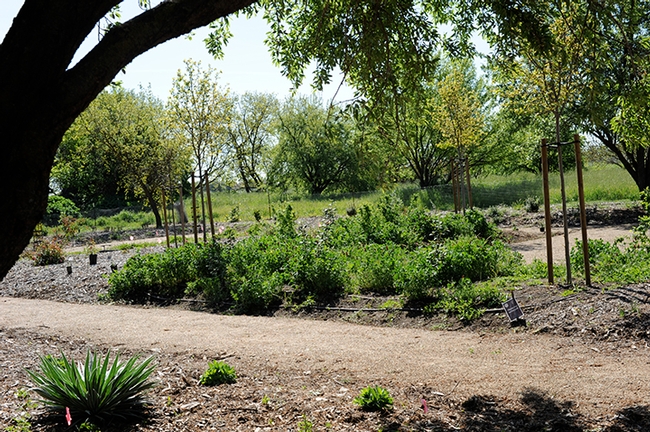
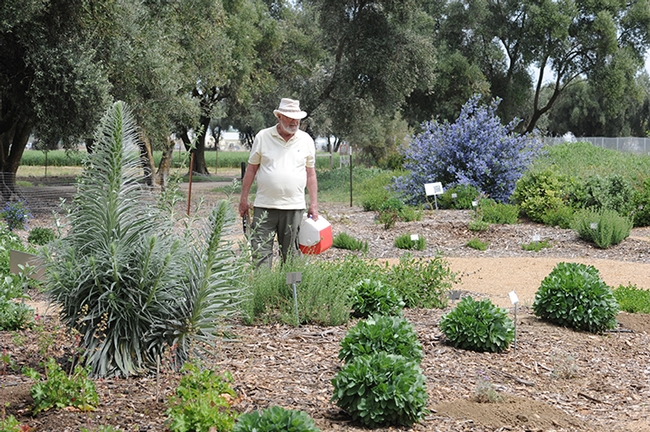
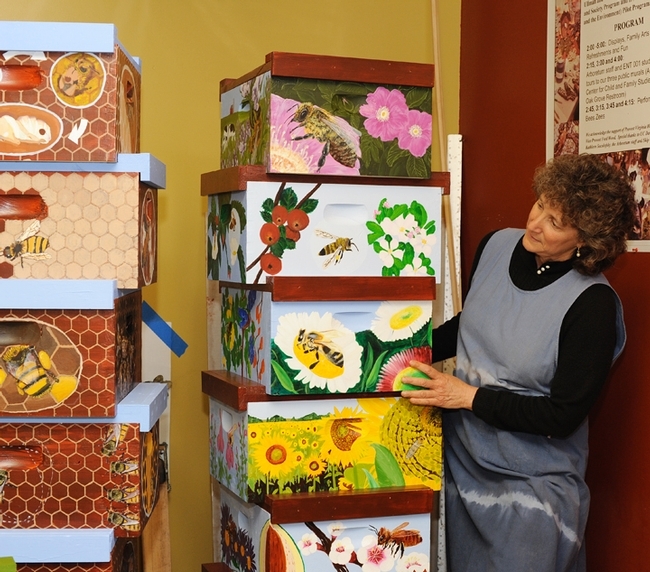
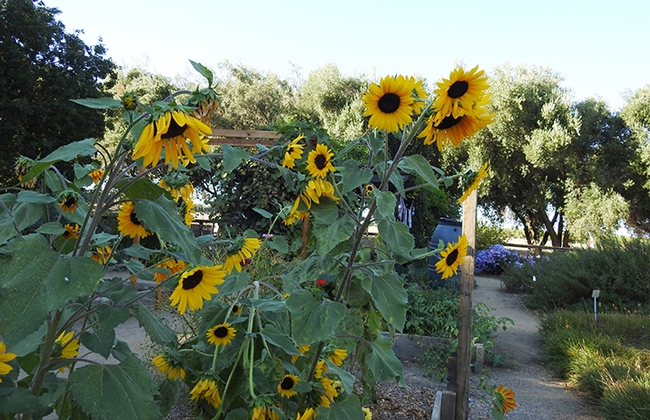
- Author: Kathy Keatley Garvey
The katydid, as green as the leaves around it, is feeding on a yellow rose. It is paying no attention to the circling honey bees.
The bees want nectar, not an encounter with a critter far bigger than they are.
The katydid slowly moves from one devastated blossom to a bud.
The honey bees head off for other blossoms.
Such was the scene in our pollinator garden in Vacaville, Calif. last weekend with a fork-tailed bush katydid claiming a yellow rose.
According to the University of California Statewide Integrated Pest Management Program (UC IPM), the fork-tailed bush katydid, Scudderia furcata, is a pest of fruit such as citrus, pear, nectarine, apricots, plums, blueberries and the like.
It also seems to like our yellow rose, "Sparkle and Shine," a variety related to the "Julia Child Rose." We purchased it back in 2013 at the annual May rose sale hosted by the California Center for Urban Horticulture (CCUH) at Foundation Plant Services, on Hopkins Road, west of the central campus.
Honey bees generally don't like commercial roses (they prefer nectar-rich plants like lavender, African blue basil, sedum, sunflowers, bee balm and salvia), but they do this one.
So does the katydid.
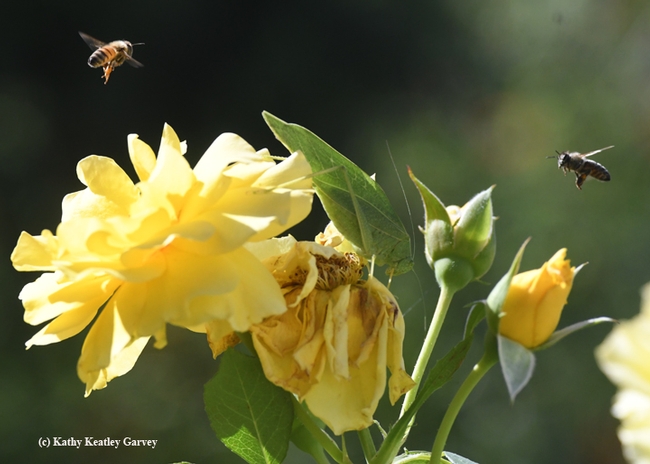
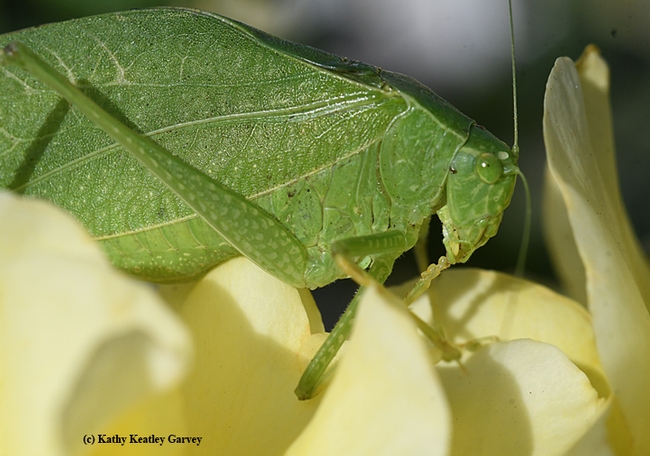
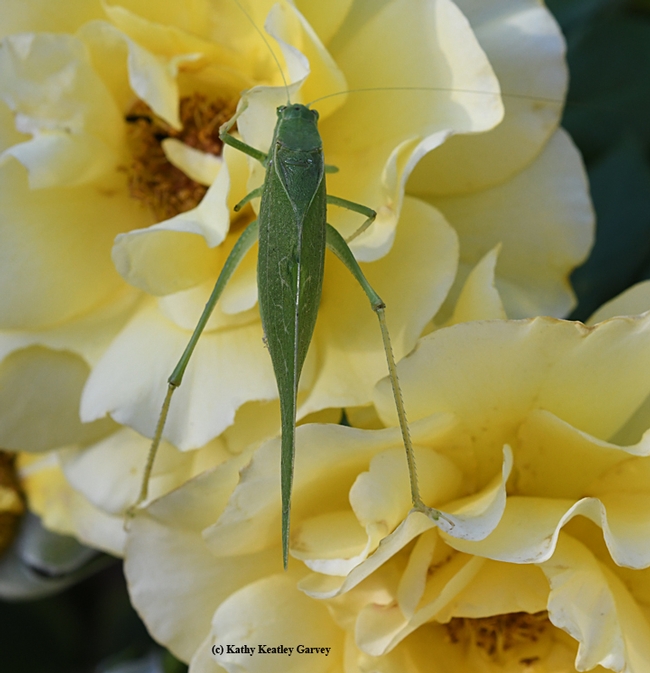

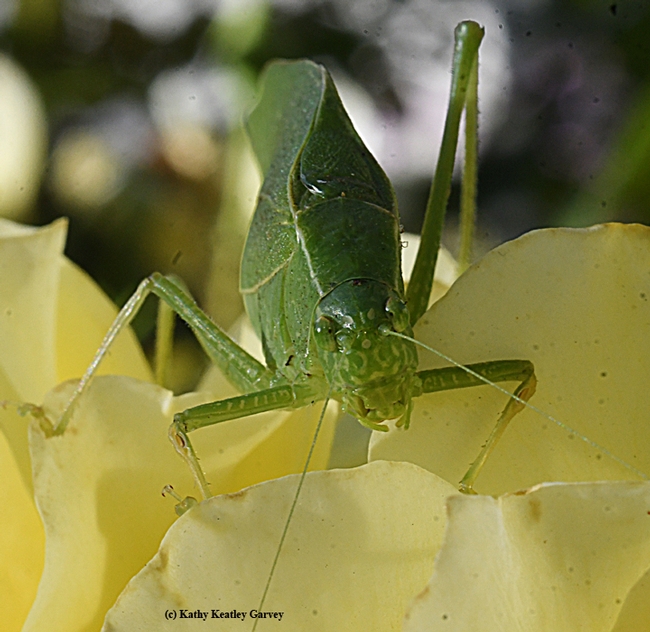
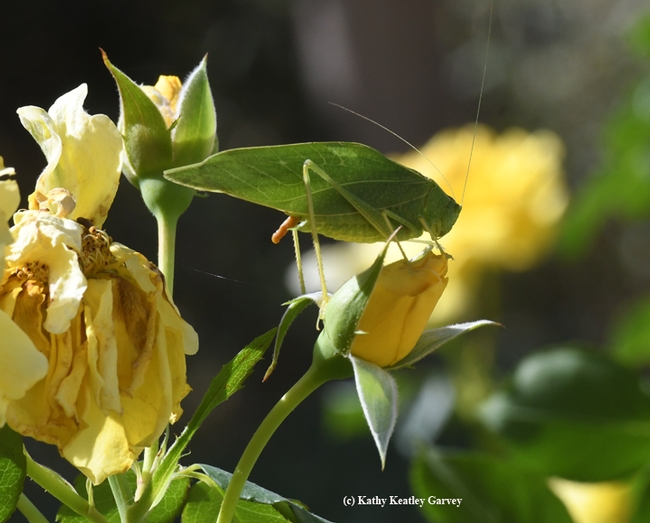
- Author: Kathy Keatley Garvey
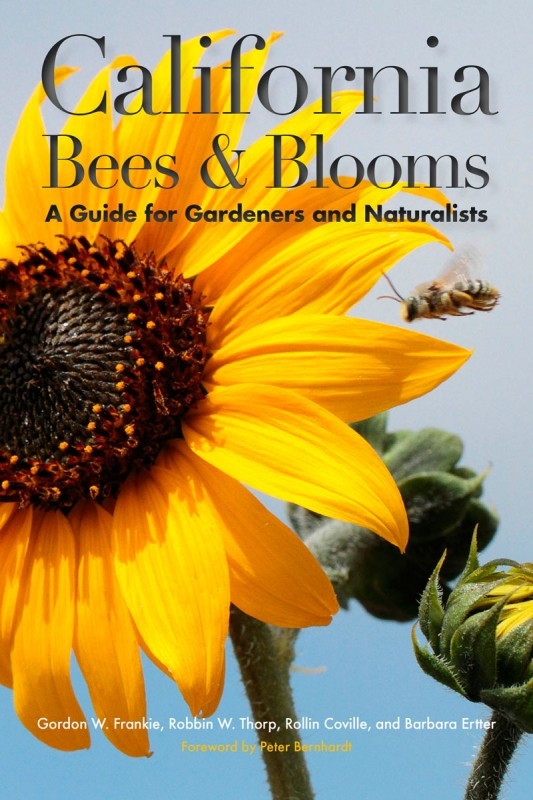
It's a shame we all can't clone ourselves and be in two places at the same time! The 40th annual Western Apicultural Society conference at the University of California, Davis, just concluded and now several more items appear on the University of California calendar.
California Center for Urban Horticulture's 'Bee-ing a Better Bee Gardener'
The California Center for Urban Horticulture, UC Davis, and the UC Davis Department of Entomology and Nematology are co-sponsoring a workshop," Bee-ing a Better Bee Gardener, focusing on pollinators in the garden, from 7:30 a.m. to 3 p.m. on Saturday, Sept. 23 in Room 2 of Kleiber Hall, UC Davis campus. It's a fundraiser for the Häagen-Dazs Honey Bee Haven, a half-acre garden next to the Harry H. Laidlaw Jr. Honey Bee Research Facility on Bee Biology Road.
Following the program at Kleiber Hall, participants will visit the haven and are invited to purchase plants at a pollinator plant sale.
Organizers said that "you should plan to attend only if you are a Master Gardener, 'keen' gardener, or have an introductory background knowledge to one of the following: entomology, botany, horticulture, or plant/insect morphology or taxonomy.
The registration fee of $50 includes a continental breakfast and lunch. For more information, contact program manager Eileen Hollett at eahollett@ucdavis.edu or (530)-752 6642.
UC Hopland Research and Extension Center's "Native Bees in Your Backyard"
The UC Hopland Research and Extension Center has scheduled a four-hour program, from 10 a.m. to 2 p.m. on Saturday, Sept. 23 on "Native Bees in Your Backyard" at two sites in Hopland. UC Berkeley professor Gordon Frankie and entomologist/photographer Rollin Coville, co-authors of California Bees and Blooms: A Guide for Gardeners and Naturalists, will discuss native bees. They will be joined by Kate Frey, award-winning gardener and co-author of “The Bee-Friendly Garden" who will provide a guided tour of her gardens and explain what plants attract pollinators. Her gardens are renowned for their floristic diversity, color and the habitats they provide for wildlife.
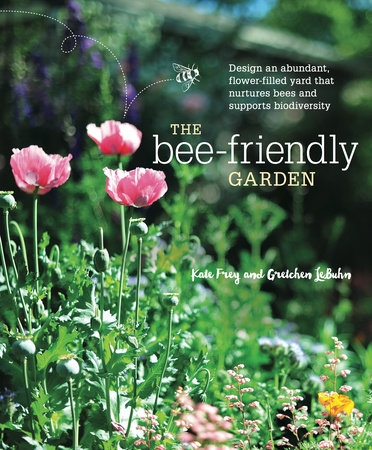
Hannah Bird, community educator at the Hopland Research and Extension Center, says attendees will "learn about some of the 1600 native bee species found in California--from the leafcutting bee to the cuckoo bee, the sweat bee to the mining bee!" They will learn how to identify them and how to accommodate their needs. For more information and directions, Bird can be contacted at hbird@ucanr.edu or (707) 744-1424, Ext. 105.
If you haven't purchased your copy of California Bees and Blooms, it's a treasure. It's the work of Gordon Frankie and photographer Rollin Coville (as mentioned above); Robbin Thorp, distinguished emeritus professor of entomology at UC Davis; and Barbara Ertter, UC Berkeley botanist. It's been described as a landmark book.
And now, one more!
Ready for one more? This one, however, is free, and no reservations are required. The Bohart Museum of Entomology of UC Davis will host an open house, "Insects and U," on Sunday, Sept. 24, 1 to 4 p.m. in Room 1124 of the Academic Surge Building on Crocker Lane. The open house, a family friendly event, is free and open to the public of all ages.
"This purposely coincides with UC Davis dorm move-in weekend," says Tabatha Yang, education and outreach coordinator. "Our target audience is new students and their families, but everyone is welcome. The focus is how to study insects at home and in school--any age."
Entomologist Jeff Smith, who curates the moth and butterfly collection, will show attendees how to pin and spread butterflies during the three-hour open house. Smith, a resident of Rocklin, curates the 400,000-specimen (and growing) collection. The entomologist has spread the wings of more than 200,000 butterflies and moths, or about 7000 a year, since 1988. “I do most of the work at my home, where I spread and identify specimens and add them to the museum collection,” he said.
“My life is dedicated to this passion of entomology,” said Smith, an associate of the Bohart Museum and a member of the Bohart Museum Society and the Lepidopterists' Society. He was named a recipient of the UC Davis College of Agricultural and Environmental Sciences' "Friend of the College" award in 2015.
Undergraduate advisor Brandy Fleming will be on hand (tabling) to talk about classes, careers, and fun with entomology. Yang is also planning a display featuring cabbage white butterflies for educators.
The Bohart Museum, directed by Lynn Kimsey, UC Davis professor of entomology, is a world-renowned insect museum that houses a global collection of nearly eight million specimens. It also maintains a live “petting zoo,” featuring walking sticks, Madagascar hissing cockroaches, walking sticks, praying mantids, and tarantulas. A gift shop, open year around, offers T-shirts, sweatshirts, books, jewelry, posters, insect-collecting equipment and insect-themed candy.
The Bohart Museum's regular hours are from 9 a.m. to noon and 1 to 5 p.m. Mondays through Thursdays. The museum is closed to the public on Fridays, Saturdays and Sundays and on major holidays. Admission is free.
For more information, email bmuseum@ucdavis.edu or access the website or Facebook page.
So there you have it--bees and gardens on Saturday, Sept. 23, and "Insects and U" (including butterflies) on Sunday, Sept. 24.
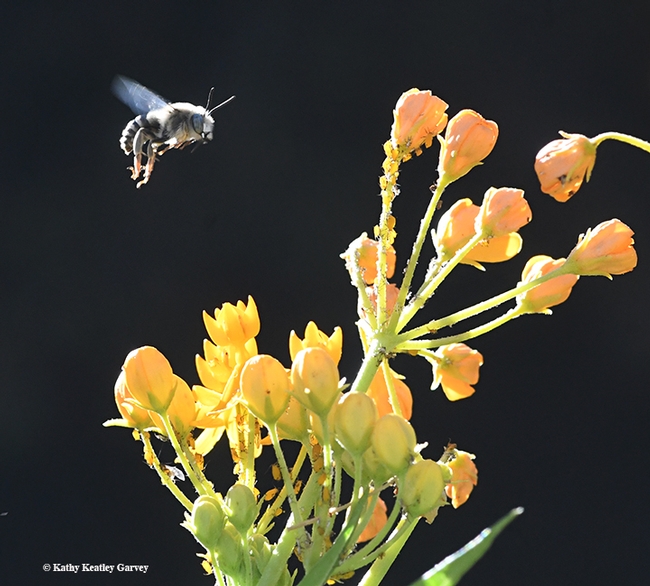
- Author: Kathy Keatley Garvey
Back in May of 2013, we headed over to the California Center for Urban Horticulture (CCUH) Annual Rose Days on the University of California, Davis, campus.
A cultivated yellow rose--Sparkle and Shine, related to the Julia Child Rose--caught our eye. Maybe it was because a honey bee was foraging on it. Maybe not.
Today, this floribunda rose is thriving like no other! Its enticing fragrance and bursts of blooms: stunning!
The lone honey bee didn't come with it, but the rose continues to attract bees. Of course, we all know that honey bees prefer such flowers as lavender, borage, bee balm, cosmos, zinnias, goldenrod, mallow and catmint, but don't tell that to the honey bees that frequent our Sparkle and Shine!
And now, it's that time again. CCUH, directed by Dave Fujino, and the UC Master Gardeners, directed by Missy Gable (former program manager of CCUH), are sponsoring their 10th Annual Rose Days from 10 a.m. to 4 p.m., Saturday, May 6 and from 10 a.m. to 4 p.m., Sunday, May 7 at the Foundation Plant Services, 455 Hopkins Road (off Hutchinson Road, west of the central campus). Admission is free.
CCUH says that the weekend will feature rose sales; bus tours to the nearby 8-acre, virus-tested rose fields on Saturday led by Foundation Plants Services; and booths staffed with Master Gardeners and Rosarians from the Woodland Library Rose Club, where they will answer your questions about roses, including how to plant, prune and maintain them. You can also ask them other horticulture-related questions.
This year there are 28 varieties to choose from: see the list on the FPS Rose Encyclopedia: http://fps.ucdavis.edu/roses/collection.cfm?roseday=y. You'll see photos and descriptions of such roses as Angel Face, Drop Dead Red, Ketchup & Mustard, Lemon Splash and All My Loving (perfect for Mother's Day)! New this year: sweet potato plants, according to new program manager Eileen Hollett. A free mini-rose, while supplies last, will be given to attendees.
You can also check out the CCUH website for further information:
http://ccuh.ucdavis.edu/Events/rose-days-may-6th-may-7th-2017
Meanwhile, our yellow rose, true to its name, continues to Sparkle and Shine.
Oh, here comes another bee!
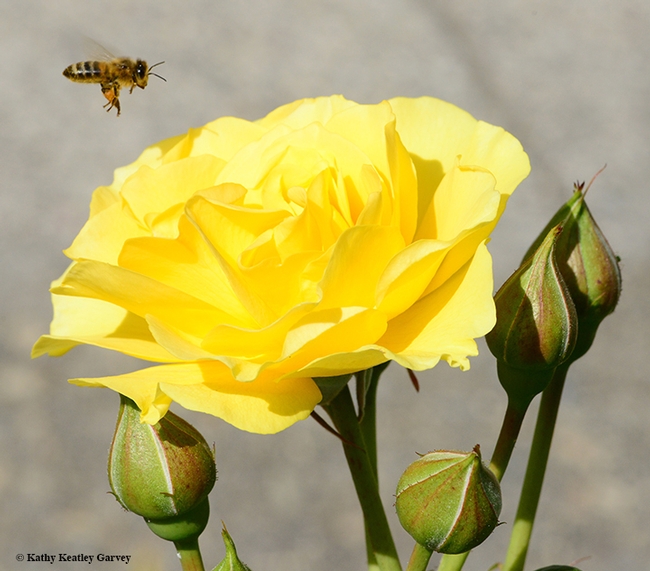
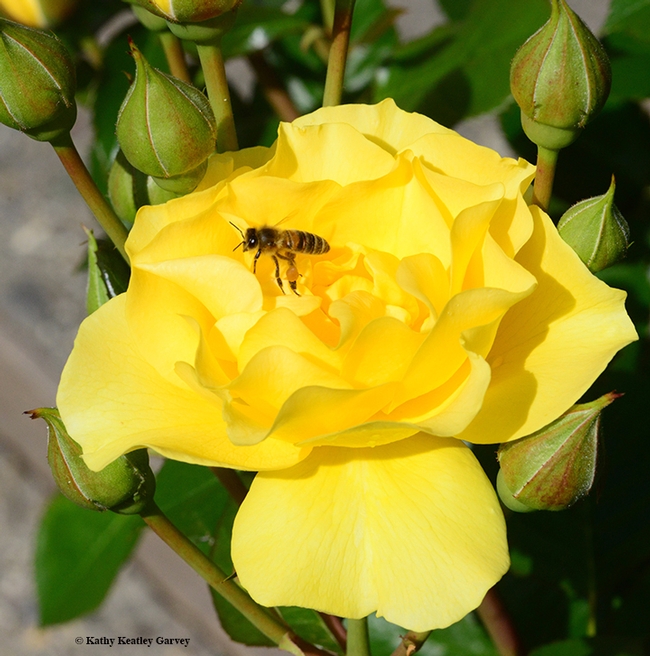
- Author: Kathy Keatley Garvey
There's gold on them thar roses.
No, not the kind of gold found during the California Gold Rush (1848–1855) that brought some 300,000 folks to the Golden State.
These are gold eggs from the multicolored Asian beetle, Harmonia axyridis, that we found on our Sparkle-and-Shine roses last week. The aphids are sparkling and the lady beetles are shining.
A native of eastern Asia, the multicolored Asian beetle was introduced in California by the U.S. Department of Agriculture in 1916, and in 1964 -1965 for the biological control of pecan aphids. Later, from 1978 through 1982, released beetles took hold in Connecticut, Delaware, Georgia, Louisiana, Maine, Maryland, Mississippi, Ohio, Pennsylvania, and Washington.
The multicolored Asian beetles are tiny, about 7 mm long and 5.5 mm wide. Spots? They range from as many as 19 spots to no spots at all. Color? From red to orange to yellow and (rarely) black. A key identifying characteristic is the black M-shaped mark behind its head.
The beetles, commonly known as ladybugs (but they're beetles, not bugs), are from the family Coccinellidae and they eat lots and lots of aphids and other soft-bodied insects, including scale insects and mites.
Aphids are not your friends. With their piercing mouthparts, they suck the juices right out of your plants, including your favorite roses. Lady beetles are your friends. They have voracious appetites and can gobble up 50 to 75 aphids a day.
Lush new growth often means a gathering of aphids, which means a gathering of lady beetles. Look closely and you might seen a cluster or row of about 20 oval eggs on the leaves.
That's the gold.
And so the cycle continues.
(Note: If you're looking for more roses, the California Center for Urban Horticulture, UC Davis, has just announced its 10th annual Rose Days will be Saturday and Sunday, May 6-7, from 10 a.m. to 4 p.m. at the Foundation Plant Services parking lot, 455 Hopkins Road, UC Davis campus.)
